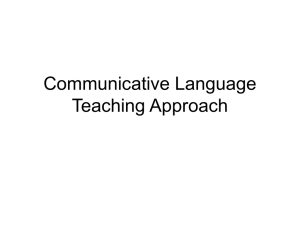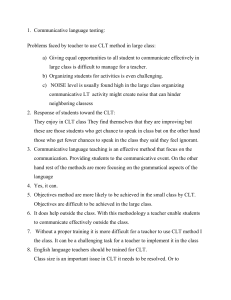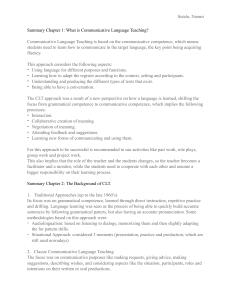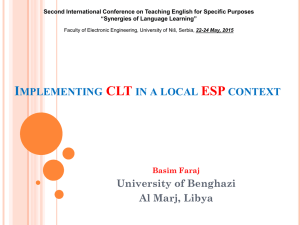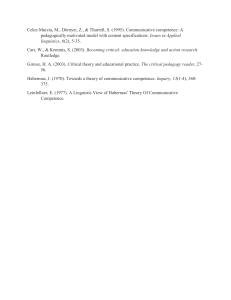Uploaded by
Sound of Victims
CLT Trends in Oman: Communicative Language Teaching Research
advertisement
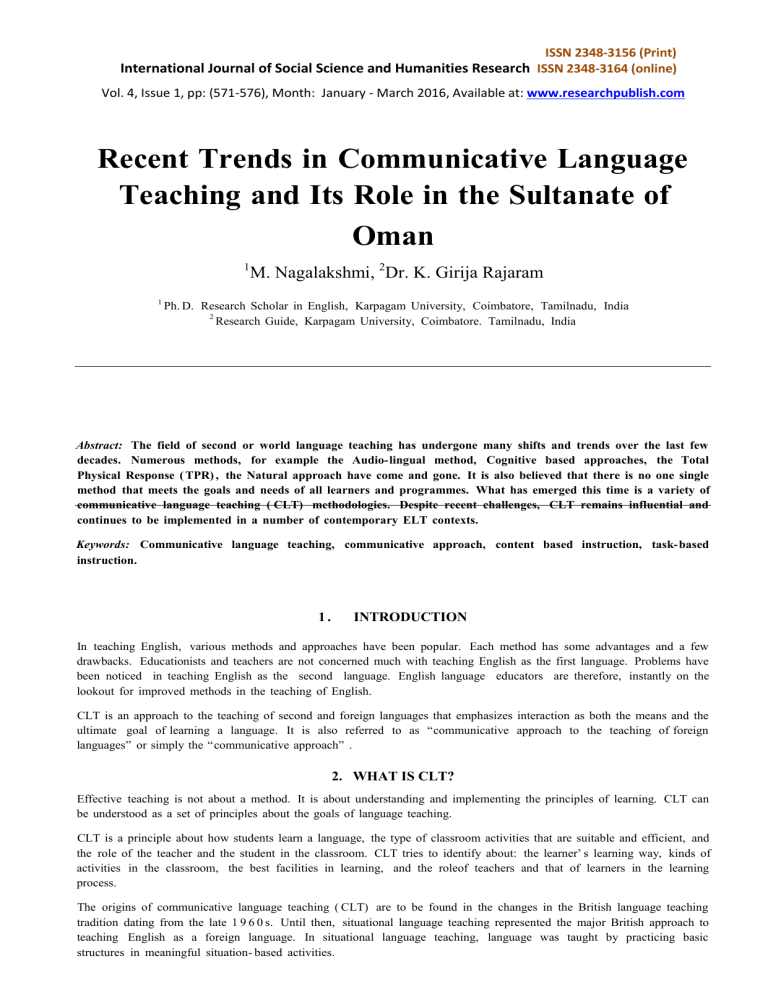
ISSN 2348-3156 (Print) International Journal of Social Science and Humanities Research ISSN 2348-3164 (online) Vol. 4, Issue 1, pp: (571-576), Month: January - March 2016, Available at: www.researchpublish.com Recent Trends in Communicative Language Teaching and Its Role in the Sultanate of Oman 1 1 M. Nagalakshmi, 2Dr. K. Girija Rajaram Ph. D. Research Scholar in English, Karpagam University, Coimbatore, Tamilnadu, India 2 Research Guide, Karpagam University, Coimbatore. Tamilnadu, India Abstract: The field of second or world language teaching has undergone many shifts and trends over the last few decades. Numerous methods, for example the Audio-lingual method, Cognitive based approaches, the Total Physical Response ( TPR) , the Natural approach have come and gone. It is also believed that there is no one single method that meets the goals and needs of all learners and programmes. What has emerged this time is a variety of communicative language teaching ( CLT) methodologies. Despite recent challenges, CLT remains influential and continues to be implemented in a number of contemporary ELT contexts. Keywords: Communicative language teaching, communicative approach, content based instruction, task-based instruction. 1. INTRODUCTION In teaching English, various methods and approaches have been popular. Each method has some advantages and a few drawbacks. Educationists and teachers are not concerned much with teaching English as the first language. Problems have been noticed in teaching English as the second language. English language educators are therefore, instantly on the lookout for improved methods in the teaching of English. CLT is an approach to the teaching of second and foreign languages that emphasizes interaction as both the means and the ultimate goal of learning a language. It is also referred to as “communicative approach to the teaching of foreign languages” or simply the “communicative approach” . 2. WHAT IS CLT? Effective teaching is not about a method. It is about understanding and implementing the principles of learning. CLT can be understood as a set of principles about the goals of language teaching. CLT is a principle about how students learn a language, the type of classroom activities that are suitable and efficient, and the role of the teacher and the student in the classroom. CLT tries to identify about: the learner’ s learning way, kinds of activities in the classroom, the best facilities in learning, and the roleof teachers and that of learners in the learning process. The origins of communicative language teaching ( CLT) are to be found in the changes in the British language teaching tradition dating from the late 1 9 6 0 s. Until then, situational language teaching represented the major British approach to teaching English as a foreign language. In situational language teaching, language was taught by practicing basic structures in meaningful situation- based activities. In planning a language course, decisions have to be made about the content of the course, including decisions about what vocabulary and grammar to teach at the beginning, at the intermediate, and advanced levels and which skills and micro Page | 571 Research Publish Journals ISSN 2348-3156 (Print) International Journal of Social Science and Humanities Research ISSN 2348-3164 (online) Vol. 4, Issue 1, pp: (571-576), Month: January - March 2016, Available at: www.researchpublish.com skills to teach and in what sequence. Decisions about these issues belong to the field of syllabus design or course design. Decisions about how best to teach the contents of a syllabus belong to the field of methodology. Language teaching has seen many changes in ideas about syllabus design and methodology in the last 5 0 years, and CLT has prompted a rethinking of approaches to syllabus design and methodology. We may conveniently group trends in language teaching in the last 5 0 years into three phases: Phase 1 – traditional approaches (up to the late 1960s) Phase 2 – classic communicative language teaching (1970s to 1990s) Phase 3 – current communicative language teaching (late 1990s to the present) PHASE 1 -TRADITIONAL APPROACHES (UPTO THE LATE 1 9 6 0 S): Traditional approaches to language teaching gave priority to grammatical competence as the basis of language proficiency. They werebased on the belief that grammar could be learned through direct instructionand through a methodology that made much use of repetitive practice and drilling. This approach to the teaching of grammar was a deductive one: students werepresented with grammar rules and then given opportunities to practice usingthem, as opposed to an inductive approach in which students are given examplesof sentences containing a grammar rule and asked to work out the rule forthemselves. Once a basic command ofthe language was established through oral drilling and controlled practice, thefour skills were introduced, usually in the sequence of speaking, listening, readingand writing. Techniques that were often employed included memorization of dialogues, question- and- answer practice, substitution drills, and various forms ofguided speaking andwriting practice. Great attention to accurate pronunciationand accurate mastery of grammar was stressed from the very beginning, since it was assumed that if students made errors, thesewould quickly become a permanent part of their speech. Methodologies based on these assumptions include Audiolingualism, also known as Aural- oral method, and the structural- situational approach, also known as situational language teaching. PHASE 2 – CLASSIC CLT (1970S TO 1990S): In the 1 9 7 0 s, a reaction to traditional language teaching approaches began andsoon spread around the world as older methods such as Audiolingualism andSituational Language Teaching went out of fashion. What was needed in order to use language communicativelywas communicative competence. This was a broader concept thanthat of grammatical competence. Communicative language teaching createda great deal of enthusiasm and excitement when it first appeared as a newapproach to language teaching in the 1 9 7 0 s and the 1 9 8 0 s, and language teachersand teaching institutions all around the world soon began to set theirteaching, syllabuses, and classroom materials. In planning language coursesbased on the communicative approach, grammar was no longer the starting point. New approaches to language teaching were needed. PHASE 3 - CURRENT TRENDS IN CLT: Since the 1 9 9 0 s, the communicative approach has been widely implemented, because it describes a set of very general principles grounded in the notion of communicative competence as the goal of second and foreign language teaching, and a communicative syllabus and methodology as the way of achieving this goal. Communicative language teaching has continued to evolve as our understanding of the processes of second language learning has developed. Current communicative language teaching theory and practice thus draw on a number of different educational paradigms and traditions. Since it draws on a number of diverse sources, there is no single or agreed upon set of practices that characterize current communicative language teaching. Rather communicative language teaching today refers to a set of generally agreed upon principles that can be applied in different ways, depending on the teaching context, the age of the learners, their level, learning goals and so on. 3. THE IMPORTANT CHARACTERISTICS OR THE PRINCIPLES OF CLT ARE Classroom goals are focused on all the components of the communicative competence Language techniques are designed to engage learners in the pragmatic, authentic, functional use of language for meaningful purposes It concerns with the fluency and accuracy Page | 572 Research Publish Journals ISSN 2348-3156 (Print) International Journal of Social Science and Humanities Research ISSN 2348-3164 (online) Vol. 4, Issue 1, pp: (571-576), Month: January - March 2016, Available at: www.researchpublish.com Students in communicative class ultimately have to use the language, productively and receptively A broad approach of teaching rather than a fixed teaching method Focusing on all components of communicative competence Communication goes through interaction Requiring negotiation and cooperation between the learners Fluency and accuracy based activities Develop language functions in a variety of contexts Create a real life situation in the class room The goals of CLT: The goals of language teaching are, the grammatical competence that refers to our ability to make and formed good sentences with the grammar rules and communicative competence that refers to our ability to produce a good communication based on the situation, purpose, setting, participant, and the types of texts. Communication is not always emphasizing in grammar, but how to make sentence formation in a language for meaningful communication since one can master the rule of language. 4. SOME OF THE SPECIAL ADVANTAGES OF CLT ARE Second language is a facility for a learner who is engaged in interaction and meaningful communication. Effective classroom learning tasks and exercises provide opportunities for students to negotiate meaning. Meaningful communication results from students processing content that is relevant, purposeful, interesting and engaging. Communication is a holistic process that often calls upon the use of several language skills or modalities. Language learning is facilitated both by activities that involve inductive or discovery learning of underlying rules of language use and organization as well as by those involving language analysis and reflection. Language learning is a process that involves creative use of language, and trial and error method Learners develop their own routes to language learning, progress at different needs and motivation for language learning. Successful language learning involves the use of effective learning and communication strategies. The role of the teacher in the language classroom is that of a facilitator. The classroom is community where learners learn through collaboration and sharing. There are two current methodologies that can be described as extensions of CLT. 4 .1. Content – Based Instruction (CBI): It is based on the following assumptions about the language learning People learn a language more successfully when they use language as a mean of acquiring information, rather than as an end in itself Content provides a coherent framework that can be used to link and develop all the language skills. Content – Based Instruction as the framework for a unit of work. CBI as the guiding principle for an entire course. CBI as a course that prepares students for mainstreaming. Page | 573 Research Publish Journals ISSN 2348-3156 (Print) International Journal of Social Science and Humanities Research ISSN 2348-3164 (online) Vol. 4, Issue 1, pp: (571-576), Month: January - March 2016, Available at: www.researchpublish.com CBI as the rationale for the use of English as a medium for teaching some school subjects. CBI as the framework for commercial EFL/ ESL materials. 4. 2.Task – Based Instruction: TBI argue that grammar and other dimensions of communicative competence can be developed as a by -product of engaging learners in interactive tasks. Two kinds of tasks can usefully be distinguished in TBI. 4.2.1. Pedagogical tasks: They are specially designed classroom tasks that are intended to require the use of specific types of language, for examples skills, grammar and vocabulary. 4.2.2. Real – world tasks: Willis (1996) proposes six types of tasks as the basis for TBI. 1. Listing tasks 2. Sorting and ordering 3 . Comparing 4 . Problem solving 5. Sharing personal experience 6 . Creative tasks. The range of exercise types and activities compatible with the communicative approach is unlimited, provided that such exercises enable learners to attain the communicative objectives of the curriculum, engage learners in communication, and require the use of such processes as information sharing, negotiation of meaning, and interaction, classroom activities are often designed to focus on completing tasks that are mediated through language and information sharing. 5. IN CLT THE TEACHER’S PARTICIPATION IS MORE IMPORTANT Several roles are assumed for teachers in CLT, the importance of particular roles being determined by the view of CLT adopted. Breen and Candlin describe teacher roles in the following terms: The teacher has two main roles: the first role is to facilitate the communication process between all participants in the classroom, and between these participants and the various activities and texts. The second role is to act as an independent participant within the learning- teaching group. The latter role is closely related to the objectives of the first role and other responsibilities arise from it. These roles imply a set of secondary roles for the teacher, first as an organizer of resources and as a resource himself, second as a guide within the classroom procedures and activities. The third role for the teacher is that of researcher and learner, with much to contribute in terms of appropriate knowledge and abilities, actual and observed experience of the nature of learning and organizational capacities. There are two salient features that surround the role of English in Oman. The first factor could be described as English for academic purposes. This entails the motivation for learning English as an additional language as a means of obtaining ajob in one ofthe higher status white collar professions, most of which are found in the public sector. The second factor is linked to national economic and social development goals, namely the government policy of “ Omanisation” . The purpose of this policy is to reduce the Sultanate’ s reliance on both skilled and unskilled expatriate labour. The driving force behind the policy is the education of nationals and their placement in key positions in public sector ministerial and oil industry related jobs. Although the governing authorities in Oman have embraced English as an official foreign language, it is generally accepted that one needs to learn English in order to enter the higher education system. Moreover, the need to react to the challenges presented by a rapidly globalising world has been realized. Proficiency in English, therefore, has an instrumental value in that the Sultanate provides generous scholarships for tertiary studies abroad to graduate students with high scores. Page | 574 Research Publish Journals ISSN 2348-3156 (Print) International Journal of Social Science and Humanities Research ISSN 2348-3164 (online) Vol. 4, Issue 1, pp: (571-576), Month: January - March 2016, Available at: www.researchpublish.com Private sector businesses in Oman are mainly owned and controlled by the Omani nationals. It is only possible to do business if one has the necessary “ sponsorship” of a local or if the business is a local- foreign joint venture. Private sector business is strictly controlled in Oman and it is not possible for foreigners to purchase freehold land. Of the importance of English in the private sector, Al- Issa has the following to say: It is believed that the private sector can contribute to the national development of the country as much as the public can. Recently, in Oman stress is being laid on the private sector and the quality of contribution it can make to the country’ s national development. The private sector has been encouraged by the government to play a more dynamic, productive and active role in facilitating the Sultanate’ s development than it used to a decade ago in the past. This has been materialising steadily in the form of private colleges, universities, hospitals, more factories and plants and so forth. These enterprises are believed to provide and create more job opportunities for the Omani graduates. English is also the medium of instruction in these newly opened private colleges and universities. This should help change the public and students’ attitudes about the place of English internationally and domestically (Al-Issa: 2002: 52). Much research has not taken place, and not many research papers have not been published with regard to ESL teaching and the CLT approach in particular, in the Sultanate of Oman. The reasons given are that most people involved in higher education have heavy workloads in addition to lacking incentive. One of the most prolific researchers in thefield of ESL in Oman is Dr. Ali Al- Issa of Sultan Qaboos University in Muscat, the main teacher training institute in Oman, who has the following to say: “The Omani government has, therefore, opted for English as its only official foreign language… English has been considered a functional tool for “ Omanisation” – a systematic and gradual replacement of foreign skilled labour by nationals. In fact, functional competence in English is a prerequisite for finding a white -collar job in the public and private sectors. … . Oman has, hence, embraced English and placed it at the heart of its educational planning, which has led to theinvestment of multimillion [ sic] US dollars since His Majesty Sultan Qaboos Bin Said came to power in 1 9 7 0 ( 2 0 0 6 : 4)” . 6. CONCLUSION To sum up, the above discussion is relevant to the research focus and valid suggestions have been put forward as to why the practice of CLT is best considered is an approach rather than a method. Thus, although a reasonable degree of theoretical consistency can be discerned at the levels of language and learning theory, at the levels of design and procedure, and there is a much greater room for individual interpretation and variation than most methods permit. Even proficient English first language speaker instructors may find the implementation of the CLT approach demanding in that flexibility and fluency are needed to cope with the use of the approach in the classroom context. It could be that one version among the various proposals for syllabus models, exercise types and classroom activities may gain wider approval in the future, giving CLT a status similar to other teaching methods. REFERENCES [ 1] Al- Issa, A. S. 2 0 0 2 . An ideological and discursive analysis of English language teaching in the Sultanate of Oman. Unpublished doctoral dissertation, University of Queensland: Australia. [ 2] Al- Issa, A. S. 2 0 0 6 . The cultural and economic politics of English language teaching inSultanate of Oman. Asian EFL Journal 8 (1): 9. [Online] Available: http://www.asian-efl-journal.com/March_06_asmi.php [ 3] Brown, H. D. (1987 ). Principles of language learning and teaching (2nd ed. ). Englewood Cliffs, NJ: Prentice Hall Regents. [ 4] Brown, H. D. (1994). Teaching by principles: An interactive approach to language pedagogy. Englewood Cliffs, NJ: Prentice Hall Regents. [5] Brown, H. D. ( 2 0 0 0 ) . Principles of language learning and teaching ( 4 th ed. ) . White Plains, New York: Addison Wesley Longman, Inc. Page | 575 Research Publish Journals ISSN 2348-3156 (Print) International Journal of Social Science and Humanities Research ISSN 2348-3164 (online) Vol. 4, Issue 1, pp: (571-576), Month: January - March 2016, Available at: www.researchpublish.com [ 6] Brown, H. D. (200 2). English language teaching in the "post-method" era: Toward Betterdiagnosis, treatment, and assessment. In J. C. Richards & W. A. Renandya ( Eds. ) , Methodology in language teaching: An anthology of current practice (pp. 9- 18).Cambridge: Cambridge University Press. [ 7] Candlin, C (1987). Toward Task-Based Language Learning inCandlin and D. My (Eds).,Oxford: Oxford University Press. [8] Larsen-Freeman, D. (1986). Techniques and principles in language teaching. New York: Oxford University Press. [9] Larsen-Freeman, D. (2000). Techniques and principles in language teaching (2nd ed.). New York: Oxford University Press. [ 1 0 ] Richards, J. c. , & Renandya, W. A. ( Eds. ) . ( 2 0 0 2 ) . Methodology in language teaching: An anthology of current practice. Cambridge: Cambridge University Press. [ 1 1 ] Richards, J. C. , & Rodgers, T. ( 1 9 8 6 ) . Approaches and methods in language teaching: A description and analysis. Cambridge: Cambridge University Press. [ 1 2 ] Richards, J. c. , & Rodgers, T. ( 2 0 0 1 ) . Approaches and methods in language teaching: A description and analysis (2nd ed.). Cambridge: Cambridge University Press. [ 1 3 ] Richards, J. C. & Schmidt, R. ( 2 0 0 2 ) . Longman dictionary of language teaching & applied linguistics ( 3 rd ed. ) . London: Pearson Education Limited. [ 1 4 ] Rodgers, T. ( 2 0 0 1 , September) . Language teaching methodology. Retrieved February 2 2 , 2 0 0 4 , fromhttp: / / www. cal. org/ resources/ digest/ rodgers. html. Page | 576 Research Publish Journals
